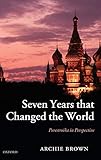Seven years that changed the world : Perestroika in perspective / Archie Brown.
Material type: TextLanguage: English Publication details: Oxford ; New York : Oxford University Press, 2007.Description: xx, 350 pages ; 24 cmISBN:
TextLanguage: English Publication details: Oxford ; New York : Oxford University Press, 2007.Description: xx, 350 pages ; 24 cmISBN: - 9780199282159 (alk. paper)
- 0199282153 (alk. paper)
- 7 years that changed the world
- 947.085/4
- 338 DK 288 B877s 2007
| Item type | Current library | Home library | Collection | Shelving location | Call number | Copy number | Status | Date due | Barcode |
|---|---|---|---|---|---|---|---|---|---|
 Libro
Libro
|
Biblioteca Juan Bosch | Biblioteca Juan Bosch | Recursos Regionales | Recursos Regionales (2do. Piso) | 338 DK 288 B877s 2007 (Browse shelf(Opens below)) | 1 | Available | 00000174199 |
Browsing Biblioteca Juan Bosch shelves, Shelving location: Recursos Regionales (2do. Piso), Collection: Recursos Regionales Close shelf browser (Hides shelf browser)

|

|

|

|

|

|

|
||
| 112 F 1236.7 D352d 2022 La disputa por México : dos proyectos frente a frente para 2024 / | 315 DP 245 P438 2022 3 de julio de 1898 : el fin del imperio español / | 315 HN 583.5 M723c 2021 Contra la España vacía / | 338 DK 288 B877s 2007 Seven years that changed the world : Perestroika in perspective / | 333 DS 135 F828d 2021 The diary of a young girl : the definitive edition / | 315 DP 171 M385e 2021 Espías el imperio : historia de los servicios secretos españoles en la época de los Austrias / | 002 E 902 O66w 2004 Who's looking out for you? / |
Includes bibliographical references and index.
PART 1 ; 1. Introduction ; PART 2 ; 2. Gorbachev: New Man in the Kremlin ; 3. The First Phase of Soviet Reform, 1985-86 ; 4. Fundamental Political Change, 1987-89 ; 5. Reconstructing the Soviet Political System ; PART 3 ; 6. Institutional Amphibiousness or Civil Society? The Origins and Development of Perestroika ; 7. The Dismantling of the System and the Disintegration of the State ; 8. Transnational Influences in the Transition from Communism ; 9. Ending the Cold War ; 10. Gorbachev and His Era in Perspective ; Index
This book is a rigorously argued and lively interpretation of the transformation of the Soviet system, the disintegration of the Soviet state, the end of the Cold War, and the role of Mikhail Gorbachev. Written by a leading authority on Soviet politics, this thoroughly researched book draws on new archival sources and puts perestroika in fresh perspective. Perestroika began as an attempt by a minority within the leadership of the Communist Party to reform the Soviet system. The decisive role was played by the new General Secretary, Mikhail Gorbachev. Perestroika (reconstruction) developed into an attempt to move from Communism to competitive elections and a market economy of a social democratic type. This 'revolution from above' had profound consequences, both intended and unintended. The latter included the dissolution of the Soviet state. Four of the ten chapters were written in 'real time'--in the second half of the 1980s while perestroika was still underway. The other six chapters provide an up-to-date discussion of such important issues as the stimuli to perestroika, its intellectual origins and development, its influence on other countries and their influence on developments in the Soviet Union, and the ending of the Cold War"--Publisher description


There are no comments on this title.